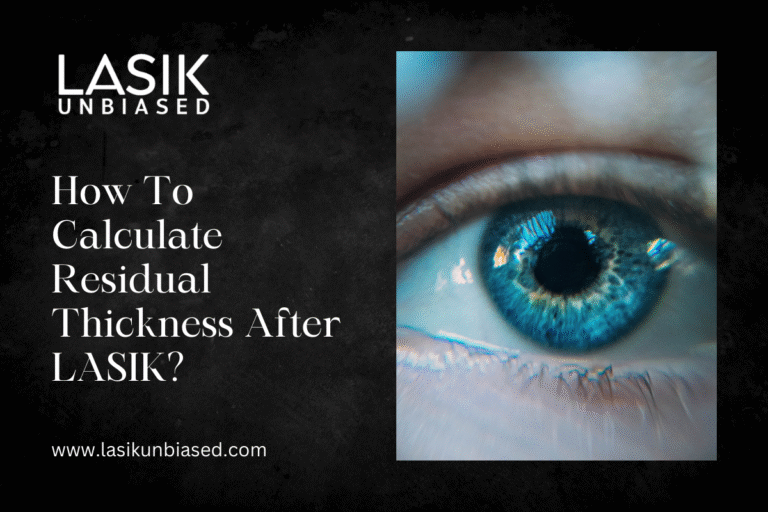Residual corneal thickness after LASIK is calculated by subtracting the sum of the corneal flap thickness and the amount of corneal stroma ablated during surgery from the original corneal thickness.
This critical measurement ensures your eye maintains structural integrity and reduces the risk of complications like ectasia. Understanding how to calculate residual thickness empowers patients and professionals to assess safety and plan effective treatments.
What Is Residual Corneal Thickness and Why Does It Matter After LASIK?
Residual corneal thickness (RCT) refers to the thickness of your cornea remaining after laser reshaping during LASIK. This parameter is crucial because the cornea must retain enough thickness to maintain its shape and strength. If the residual thickness is too thin, the cornea can weaken, leading to complications such as corneal ectasia, where the cornea progressively bulges outward, distorting vision and sometimes requiring further surgery or corneal transplantation.
By calculating RCT accurately, surgeons ensure they remove only a safe amount of tissue and maintain the eye’s health while achieving the desired vision correction.
Understanding Preoperative Corneal Thickness: The Starting Point for Residual Thickness Calculation
Before surgery, your ophthalmologist measures your corneal thickness using tools like pachymetry or corneal topography.
- Pachymetry uses ultrasound or optical coherence tomography (OCT) to measure corneal thickness, typically expressed in microns (thousandths of a millimetre).
- Corneal topography primarily maps the shape and curvature of the corneal surface but can also provide thickness data, especially when combined with tomography techniques.
The average adult cornea is approximately 540 to 560 microns thick, but thickness varies between individuals and even across the corneal surface. Knowing your baseline corneal thickness is the foundation for determining how much tissue can safely be removed.
How To Determine the Amount of Tissue Removed During LASIK?
The second key number in the residual thickness calculation is the thickness of the corneal flap created by the surgeon, plus the amount of corneal stroma ablated (removed) by the laser.
- The corneal flap typically ranges between 100 and 160 microns, depending on the surgical technique and surgeon preferences. Flap thickness can be measured intraoperatively or estimated preoperatively using imaging to improve calculation accuracy.
- The ablation depth depends on your refractive error. The higher the prescription correction, the more tissue is removed to reshape the cornea adequately.
Ablation depth can be estimated using formulas that consider your refractive error and the laser system’s parameters; however, surgeons typically rely on the laser’s software and preoperative measurements to determine the exact amount of tissue to be removed.
The Formula to Calculate Residual Corneal Thickness After LASIK
Now, let’s get to the simple but essential formula:
Residual Corneal Thickness (RCT) = Preoperative Corneal Thickness – (Flap Thickness + Ablation Depth)
This formula subtracts the total amount of tissue altered from the original corneal thickness, leaving you with the thickness of corneal tissue that remains intact and untouched.
Note: The residual corneal thickness includes the flap, but surgeons focus mainly on the residual stromal bed thickness (the cornea beneath the flap after ablation).
Why Accurate Calculation of Residual Thickness Is Crucial for LASIK Safety?
Maintaining a minimum residual stromal bed thickness is vital for avoiding complications. The residual stromal bed (RSB) refers specifically to the corneal tissue beneath the flap that remains after ablation, and it is a critical factor in corneal strength.
Residual Stromal Bed (RSB) = Preoperative Corneal Thickness – Flap Thickness – Ablation Depth
Surgeons generally aim to leave at least 250 microns of residual stromal bed intact beneath the flap, although some may prefer a minimum of 300 microns for added safety. This residual bed supports the cornea’s biomechanical stability.
If the residual thickness falls below this threshold, the risk of post-LASIK ectasia rises, which can cause progressive vision loss and may require interventions like corneal cross-linking or transplantation.
Tools and Techniques for Measuring Corneal Thickness Before and After LASIK
Modern ophthalmology employs advanced imaging technologies to measure corneal thickness with high precision:
- Ultrasound Pachymetry: A handheld device that touches the eye’s surface to give precise thickness readings.
- Optical Coherence Tomography (OCT): A non-contact imaging method providing detailed corneal layer images and thickness maps.
- Scheimpflug Imaging: This method offers 3D corneal mapping and is useful for both pre-and post-LASIK assessments.
- Corneal Topography: Maps curvature and thickness distribution, helping identify irregularities and ensuring accurate flap creation.
These tools enable surgeons to calculate residual thickness accurately, plan treatments, and assess healing post-surgery.
How Refractive Error Influences Residual Thickness Calculation?
The degree of vision correction directly impacts ablation depth and thus residual thickness.
- Myopia (nearsightedness): Requires flattening the central cornea by removing tissue centrally; higher myopia means deeper ablation.
- Hyperopia (farsightedness): Requires steepening the cornea, often with peripheral ablation; tissue removal patterns differ but still impact thickness.
- Astigmatism: Requires asymmetric ablation patterns tailored to the cornea’s irregularities.
Understanding your specific prescription helps estimate the amount of tissue that will be removed and calculate residual thickness accordingly.
Common Misconceptions About Residual Thickness After LASIK
- “More tissue removed means better vision correction.”
This is false. Removing too much tissue compromises corneal strength and safety. The goal is to remove only what’s necessary for clear vision. - “Residual thickness can be ignored if preoperative thickness is high.”
Regardless of starting thickness, the residual bed must meet safety thresholds to avoid complications. - “Flap thickness is always the same.”
Flap thickness varies based on surgical technique (femtosecond laser vs. microkeratome) and impacts residual stromal thickness calculation.
How to Monitor Residual Thickness After LASIK Surgery?
After LASIK, follow-up exams include pachymetry or OCT imaging to verify residual thickness and corneal health. Monitoring helps detect early signs of complications, especially if residual thickness was borderline preoperatively.
If thinning or instability is detected, your surgeon may recommend treatments like corneal cross-linking to strengthen the cornea.
Practical Example: Calculating Residual Thickness Step-by-Step
Suppose your preoperative corneal thickness is 550 microns. The surgeon creates a 110-micron flap, and the laser ablates 120 microns of tissue.
Applying the formula:
RCT = 550 – (110 + 120) = 550 – 230 = 320 microns
Since 320 microns is above the general safety threshold (250-300 microns), this procedure would likely be considered safe in terms of residual thickness.
The Impact of Residual Thickness on Post-LASIK Recovery and Vision Quality
Residual corneal thickness not only affects safety but also healing and visual outcomes. Adequate thickness ensures:
- Structural corneal stability
- Reduced risk of visual distortions or regression
- Faster and more predictable recovery
Thinner residual corneas can sometimes cause fluctuating vision or longer healing times.
What to Discuss With Your Surgeon Regarding Residual Thickness?
Before LASIK, ask your ophthalmologist:
- What is my preoperative corneal thickness?
- How thick will the flap be?
- How much tissue will the laser remove for my prescription?
- What will my residual corneal thickness be?
- Is this thickness within safe limits?
- How will residual thickness impact my long-term vision and corneal health?
Understanding these points ensures you are well-informed and comfortable with the procedure plan.
Conclusion: Why Knowing How To Calculate Residual Thickness Matters?
Calculating residual thickness after LASIK is fundamental to ensuring your surgery is both effective and safe. It balances vision correction goals with maintaining corneal integrity. Accurate preoperative measurements, precise flap creation, and controlled laser ablation all contribute to achieving an optimal residual corneal thickness.
By understanding this calculation, you become an informed participant in your eye care, helping you communicate better with your surgeon and make confident decisions about your vision correction journey.
Takeaway: Always ensure your LASIK provider prioritises residual thickness calculations to safeguard your eye health and deliver lasting visual improvements.


